Cranial sacral massage is a gentle, hands-on therapy targeting the body’s craniosacral system, including the bones, nerves, and fluids of the brain and spine. This therapy aims to alleviate chronic pain, reduce stress, and improve overall well-being. This Foot Palace article will discuss the benefits, techniques, and what to expect during a cranial sacral massage session.
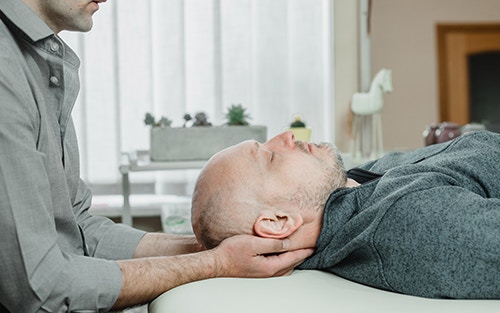
Key Takeaways
- Cranial sacral therapy (CST) utilizes light pressure to address imbalances in the craniosacral system, enhancing the functioning and overall health of the central nervous system.
- The therapy is effective in managing various conditions such as chronic pain, migraines, stress-related disorders, and neurovascular issues, offering deep relaxation and improved body function.
- CST is generally safe for most individuals, including those with sensitive conditions, though it requires practitioners with specialized training and certification.
What is Cranial Sacral Massage?
Craniosacral massage, also known as craniosacral therapy or CST, is a gentle, hands-on approach that focuses on the craniosacral system – a complex network encompassing the bones, nerves, fluids, and connective tissues of the cranium and spine. This groundbreaking treatment serves to restore equilibrium and stimulate healing by scrutinizing and rectifying imbalances in this complex system through the application of craniosacral massage techniques.
At its core, cranial sacral therapy employs light pressure, typically using just five grams of pressure – about the weight of a nickel. This feather-light approach makes it suitable for a wide range of patients, from newborns to the elderly and those with sensitive conditions. Due to its gentle nature, practitioners can align with the body’s innate rhythms, aiding in the release of deep-seated tensions within the central nervous system.
What sets cranial sacral massage apart from other forms of bodywork is its holistic approach and targeted attention to the craniosacral system. Unlike deep tissue massage, which focuses on muscular tension, cranial sacral therapy takes a more subtle approach, working with the body’s inherent healing mechanisms. Practitioners apply their skills to specific areas of the body, including the head, spine, and pelvis, to detect and correct imbalances that may be causing discomfort or dysfunction elsewhere in the body.

This distinctive modality renders cranial sacral therapy an outstanding supplement to other treatments, such as cranial osteopathy, and a worthwhile independent therapy for those seeking a gentle yet potent wellness solution.
Benefits of Cranial Sacral Massage
The advantages of cranial sacral massage are as varied as they are significant, providing relief for an extensive array of physical and emotional conditions. One of the most significant advantages of this therapy is its ability to alleviate chronic pain. By gently manipulating the craniosacral system, practitioners can help release restrictions that may be causing persistent discomfort, particularly in areas such as the neck, back, and head. Many individuals who have struggled with long-term pain find that cranial sacral therapy provides a level of relief that other treatments have not achieved.
Another key benefit of cranial sacral massage is its remarkable ability to induce deep relaxation and reduce stress. In our fast-paced world, finding moments of true calm can be challenging. However, during a cranial sacral therapy session, patients often experience a profound sense of relaxation that goes beyond mere physical comfort. This deep state of relaxation can have far-reaching effects, helping to alleviate both physical and emotional stress. As tension melts away, many people report feeling a renewed sense of clarity and well-being that persists long after the session has ended.
Beyond pain relief and stress reduction, cranial sacral massage can significantly improve overall body function. One area where this is particularly noticeable is in neck flexibility and range of motion. As the therapy works to release restrictions in the craniosacral system, many patients experience increased mobility and ease of movement, not just in the neck but throughout the body. This improved function can have a ripple effect, enhancing performance in daily activities, sports, and even cognitive tasks. The holistic nature of cranial sacral therapy means its benefits often extend far beyond the immediate areas being treated, contributing to a greater sense of overall health and vitality.
How Cranial Sacral Massage Works
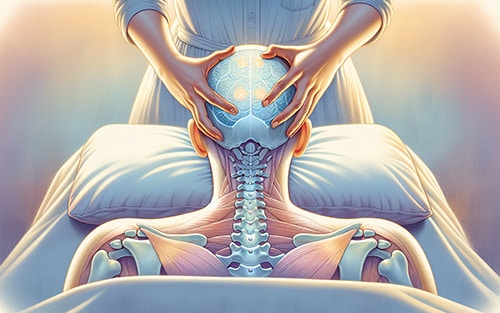
Cranial sacral massage operates on the principle that the body has an innate ability to heal itself, given the right conditions. This non-invasive therapy uses a remarkably light touch – less than 5 grams of pressure – to detect and correct imbalances in the craniosacral system. By doing so, it aims to enhance the functioning of the central nervous system, which plays a crucial role in overall health and well-being.
The therapy involves gentle manipulation of the bones, tissues, and membranes surrounding the brain, spinal cord, and sacrum, including the spinal column. Practitioners apply subtle pressure to specific areas like the head, neck, and back, using their highly trained sense of touch to identify areas of restriction or tension within the craniosacral system. Through these precise and gentle techniques, therapists work to release these restrictions, allowing for improved circulation of cerebrospinal fluid and promoting a state of balance within the body. This process is believed to facilitate the body’s natural healing mechanisms, addressing a wide range of symptoms and conditions.
Role of Cerebrospinal Fluid
Central to cranial sacral therapy is the essential function of cerebrospinal fluid (CSF). This clear, colorless fluid surrounding the brain and spinal cord is far more than just a protective cushion. It plays a vital role in the health and function of the central nervous system, influencing everything from cognitive function to physical well-being. Cranial sacral therapy focuses intently on the circulation and pressure of this fluid, recognizing its importance in maintaining optimal central nervous system function.
The delicate adjustments utilized in cranial sacral massage aim to regulate the circulation of cerebrospinal fluid. By applying subtle pressure to the bones of the skull, spine, and pelvis, practitioners aim to remove any blockages or restrictions that may be impeding the natural circulation of CSF. This process is believed to enhance the overall function of the central nervous system, promoting a state of balance and facilitating the body’s innate healing processes.
One key benefit of improving cerebrospinal fluid circulation is its potential to reduce inflammation throughout the body. When CSF flows freely, it can more effectively remove waste products and deliver nutrients to the brain and spinal cord. This enhanced circulation may help alleviate symptoms associated with various conditions, from headaches to neurological disorders.
Moreover, by ensuring there are no obstructions in what’s known as the craniosacral wave – the subtle rhythm of CSF movement – cranial sacral therapy can contribute to the resolution of a wide range of symptoms, supporting overall health and well-being.
Gentle Manipulation Techniques
A defining feature of cranial sacral therapy is its notably gentle manipulation techniques. Unlike more vigorous forms of bodywork, this therapy relies on an extremely light touch, typically using no more than 5 grams of pressure – about the weight of a nickel. This subtle approach allows practitioners to tune into the subtle rhythms and movements within the craniosacral system, detecting areas of restriction or imbalance with remarkable precision.
During a session, therapists use their hands to apply this gentle pressure to various parts of the body, mainly focusing on the head, neck, and back. These areas are key access points to the craniosacral system. The practitioner’s highly trained sense of touch allows them to perceive minute changes in tissue tension and fluid movement. Through these delicate manipulations, they work to release restrictions, encourage the free flow of cerebrospinal fluid, and restore balance to the entire system using craniosacral therapy techniques. This non-invasive approach makes cranial sacral therapy suitable for people of all ages and conditions, from newborns to the elderly, and can be particularly beneficial for those who may not tolerate more forceful manual therapies.
Conditions Treated with Cranial Sacral Massage
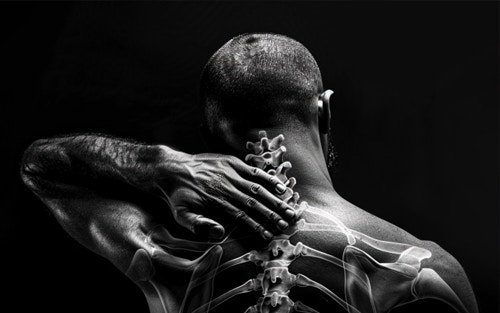
Cranial sacral massage has demonstrated notable effectiveness in managing a broad spectrum of conditions, rendering it a versatile treatment for numerous health issues. One of the most common applications of this gentle technique is in the management of chronic pain, particularly in the neck and back regions. Many individuals who have struggled with persistent discomfort find significant relief through regular cranial sacral therapy sessions. The therapy’s ability to release deep-seated tensions and improve overall body function can lead to long-lasting pain reduction and improved quality of life.
Craniosacral therapy has also demonstrated considerable success in managing migraines and headaches. By addressing imbalances in the craniosacral system and promoting the free flow of cerebrospinal fluid, this therapy can help alleviate migraines’ frequency and intensity. Many patients report a significant reduction in headache episodes and an overall improvement in their ability to manage this often debilitating condition, making craniosacral therapy work effectively for them.
Beyond pain management, cranial sacral massage has shown promise in addressing various other health issues. It can be particularly effective for:
- Stress-related disorders by offering a deeply relaxing experience that helps to calm the nervous system and reduce the physical and emotional impacts of chronic stress.
- Individuals dealing with neurovascular or immune disorders.
- Individuals with hormonal imbalances.
The therapy has also been found beneficial for these conditions.
Furthermore, cranial sacral therapy has shown potential in supporting those with conditions such as fibromyalgia, autism spectrum disorders, and post-traumatic stress disorder (PTSD). Its gentle, non-invasive nature makes it a safe and often well-tolerated complementary therapy for these complex conditions.
Preparing for Your Cranial Sacral Massage Session
Getting ready for your cranial sacral massage session is vital to optimizing the benefits of this gentle yet potent therapy. The process begins even before you arrive at the practitioner’s office. Creating a receptive mental space is beneficial, allowing yourself to be open to the experience and its potential effects. This might involve taking some time for quiet reflection or meditation before your appointment, helping to clear your mind and set positive intentions for the session. Remember, cranial sacral therapy works best when you’re able to relax and allow the practitioner to guide the process.
When it comes to practical preparations for a cranial sacral therapy session, here are some tips:
- Wear loose, comfortable clothing to allow the practitioner to work more effectively and better sense what’s happening in your body through the fabric.
- Unlike some forms of massage, you’ll remain fully clothed during a cranial sacral therapy session.
- Before the hands-on work begins, you’ll typically have a consultation with your therapist. This is an opportunity to discuss your health history, any current concerns, and your goals for the session. Be prepared to share relevant information about your physical and emotional well-being, as this will help the practitioner tailor the session to your specific needs.
- Some therapists may prefer to begin the hands-on work immediately, tuning into your body’s language, so be open to different approaches.
What to Expect During a Cranial Sacral Massage Session
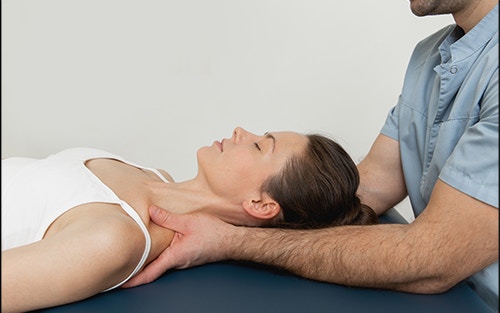
As you embark on your cranial sacral therapy journey, it’s natural to wonder what the experience will entail. A typical session usually lasts between 30 minutes and an hour, with some practitioners offering extended sessions of 45 to 60 minutes. It’s important to note that achieving your treatment goals may require multiple sessions, as the effects of cranial sacral therapy can be cumulative.
When you arrive for your appointment, your massage therapist will welcome you into a calm and soothing environment. Many practitioners create a tranquil atmosphere with soft lighting and gentle background music to enhance relaxation during your gentle massage. Your therapist will use a specific massage technique, ensuring you’ll remain fully clothed throughout the session, so there’s no need to worry about disrobing. Most commonly, you’ll lie comfortably on a massage table, although sitting in a chair is also an option if that’s more suitable for your needs.
Your session will typically begin with a brief consultation. The therapist will inquire about your health history and discuss your treatment goals. This is your opportunity to share any concerns or questions you may have. As the hands-on portion of the craniosacral therapy session begins, the therapist will explain their actions before making contact with your body. Throughout the treatment, they will check in with you to ensure your comfort and may ask for feedback about what you’re experiencing. The gentle, non-invasive nature of cranial sacral therapy means that while you may feel deeply relaxed, you’ll likely remain aware of your surroundings throughout the session.
Safety and Side Effects
Cranial sacral massage is generally considered a safe therapy for most individuals, regardless of age or condition. When performed by a trained and experienced practitioner, it’s a gentle, non-invasive treatment with minimal risk. The light touch used in this therapy means that it’s typically well-tolerated, even by those who may be sensitive to more forceful forms of bodywork. This makes cranial sacral therapy an attractive option for many people, from infants to the elderly and those with various health conditions.
While side effects are generally mild and temporary, some people may experience slight discomfort following a session. This can include temporary soreness or fatigue, which usually resolves quickly. It’s important to note that there are some situations where cranial sacral therapy may not be appropriate. For instance, individuals with a cerebrospinal fluid leak should avoid the therapy until the leak has fully healed. Additionally, those who have recently experienced acute conditions such as a stroke, cerebral hemorrhage, or aneurysm should consult with their healthcare provider before seeking cranial sacral therapy.
However, once medically stable, patients recovering from these events may find cranial sacral therapy beneficial during their recovery phase. As with any complementary therapy, it’s always wise to consult with your healthcare provider before beginning cranial sacral therapy, especially if you have any ongoing health concerns.
Finding a Qualified Practitioner
When searching for a cranial sacral therapist, it’s vital to select a practitioner who is not only proficient but also possesses a specific specialization in this area. Look for therapists who have invested significant time and training in cranial sacral therapy, as this dedication often translates to a deeper understanding and more refined skills. One of the most respected training facilities for cranial sacral therapy is the Upledger Institute, which offers comprehensive and advanced courses in this modality. Seeking a Upledger-trained therapist can be a good starting point in your search for a qualified practitioner.
When evaluating potential therapists, don’t hesitate to ask about their experience, training, and qualifications. A reputable practitioner will be happy to discuss their background and how it relates to your specific needs. It can also be helpful to inquire about the outcomes they’ve seen with clients with similar conditions. This can give you a better idea of what to expect and whether the therapist has experience in addressing your particular concerns.
Remember, finding the right practitioner is an important step in your healing journey, so take the time to find someone you feel comfortable with and confident in their abilities.
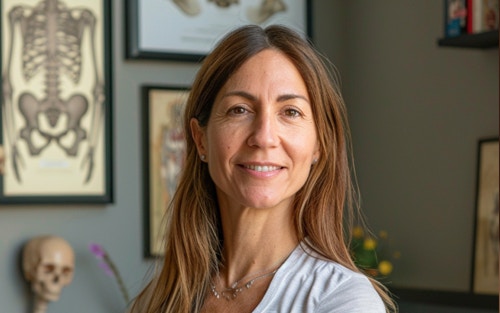
Cranial Sacral Massage Summary
Cranial sacral massage stands as a testament to the power of gentle, holistic healing approaches. Throughout this exploration, we’ve uncovered the myriad benefits of this subtle yet profound therapy – from pain relief and stress reduction to improved overall body function. We’ve delved into the craniosacral system’s intricate workings and cerebrospinal fluid’s vital role in our well-being. By understanding what to expect during a session and how to prepare, you’re now equipped to embark on your cranial sacral journey. Remember, while this therapy is generally safe and beneficial for many, it’s always wise to consult a healthcare provider and seek a qualified practitioner. As you consider integrating cranial sacral massage into your wellness routine, envision the potential for deep relaxation, improved health, and a renewed sense of balance in your life. The gentle touch of cranial sacral therapy might just be the key to unlocking a new level of well-being for you.
Frequently Asked Questions
How is cranial sacral massage different from regular massage?
Cranial sacral massage differs from regular massage by focusing on the craniosacral system with gentle touch to improve central nervous system function, whereas regular massage primarily targets muscular tension and relaxation.
How many sessions of cranial sacral therapy do I need to see results?
The number of cranial sacral therapy sessions needed varies for each individual, with some experiencing benefits after just one session and others requiring multiple sessions over time for optimal results. Your practitioner can offer personalized recommendations based on your specific needs.
Is cranial sacral massage safe for pregnant women?
Cranial sacral massage is generally considered safe during pregnancy, but it’s important to inform your practitioner and consult your healthcare provider beforehand.
Can children receive cranial sacral therapy?
Yes, children can receive cranial sacral therapy. Due to its gentle nature, it is often used to treat pediatric conditions.
Will I feel immediate effects after a cranial sacral massage session?
The immediate effects of a cranial sacral massage session can vary from person to person. While some may feel immediate relaxation or relief, others may notice effects gradually over the following days. It’s important to understand that the experience is unique to each individual.
(706) 521-5290